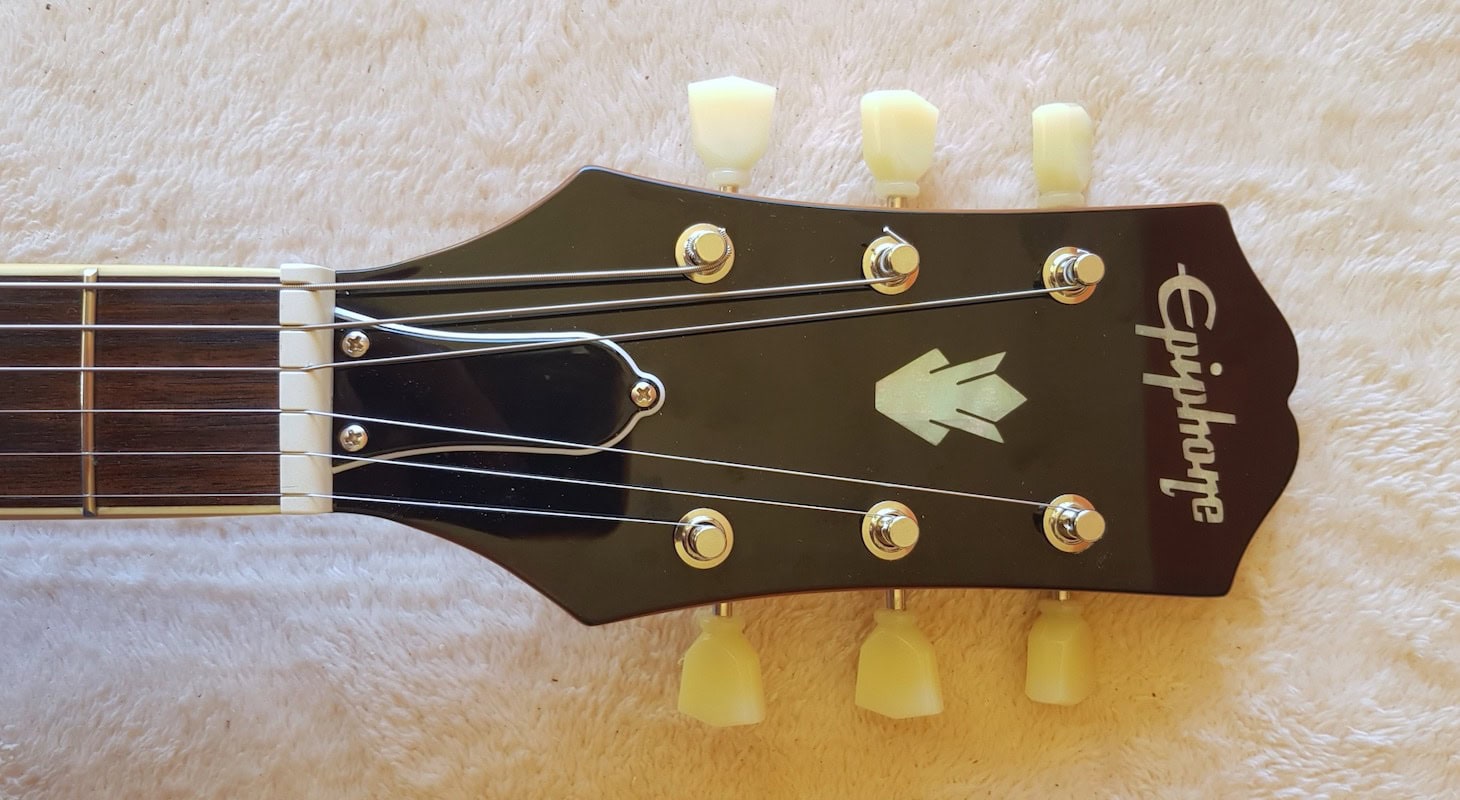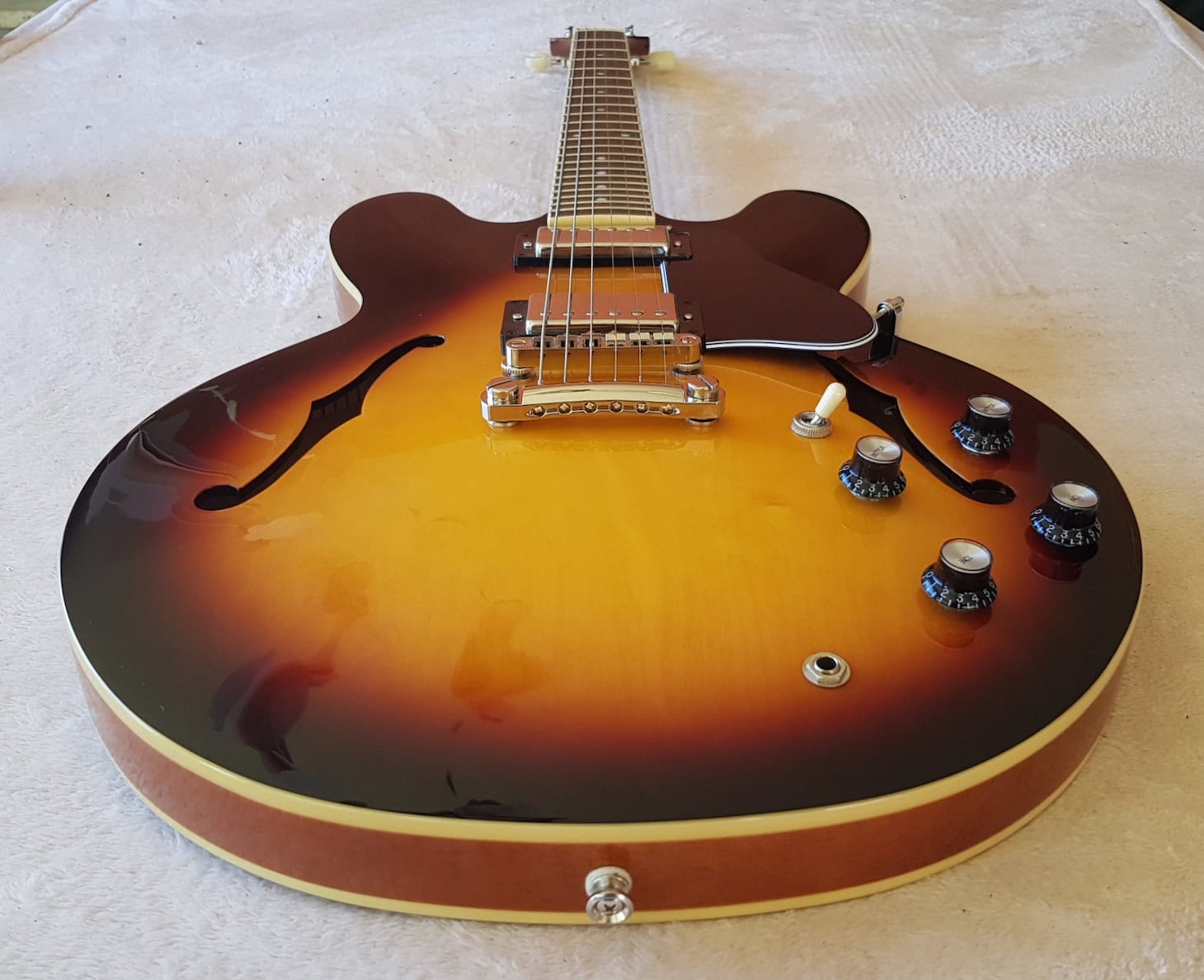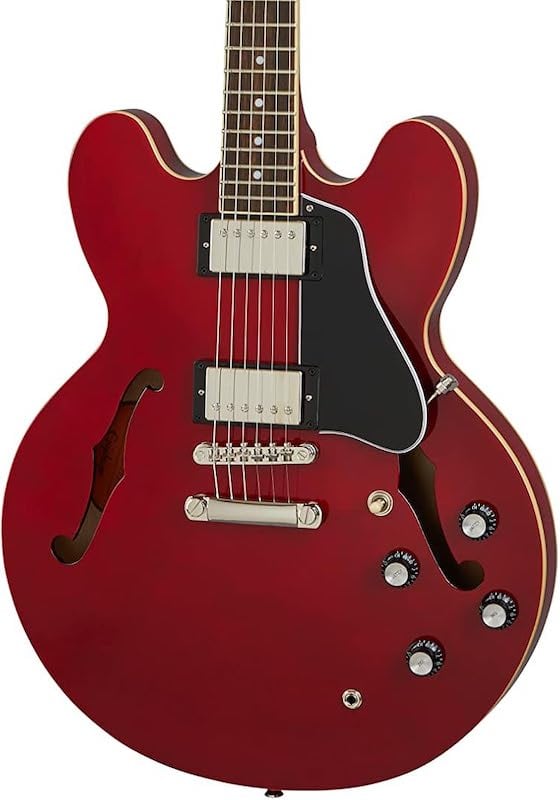One of my favorite guitars I own is my mid-90s Orville 335. It’s showing its age a little now, so I was looking at potential backup instruments, especially for live work.
I’ve always been partial to Epiphone guitars, having played plenty of Epi Les Pauls back before I owned a Gibson, so I figured I ought to try out the new Epiphone 335. Everyone I spoke to spoke in hushed, reverent tones about the new Epiphone range.
The guitars of the Far East are much better now than they were when I was learning to play. The new Epiphone range even appears on major stages all over the world.
With little to lose, I buckled up and tried out the new Epiphone ES-335.
Quick Overview
A well-built, versatile semi-hollow that handles everything from clean country licks to gritty Britpop-style crunch. Stock pickups hold it back a little, but the base guitar feels solid and ready to work.
Epiphone Expertise
Curiously, although the Epiphone ES-335 is a lower-tiered version of the full-fat Gibson model, Epiphone was once a direct competitor with Gibson’s ES (or Electro Spanish) line.
Before Gibson bought Epiphone, the two companies enjoyed a rivalry when it came to hollow body electric guitars. Epiphone’s Casino and Riviera in particular were favored by players in the 1960s, The Beatles not least among them! Gibson’s 335, on the other hand, had a reputation as an old bluesman’s guitar. It’s the instrument of Chuck Berry and BB King, although that didn’t stop Eric Clapton from wielding one in his Cream days.
All of this is to say that Epiphone has been making awesome hollow body electric guitars for decades, and there’s more to the 335 story than it simply being a Gibson knockoff.
First Impressions
The first thing I noticed about the new Epiphone is that they’ve changed the headstock! It’s closer to the familiar Gibson open-book headstock than the old Epiphone one of my youth with the corners cut off. It’s a nice touch.

Epiphone ES-335 - Headstock
I picked a model off the wall in Vintage Sunburst, largely because red 335s always make me feel like I’m impersonating Marty McFly from Back To The Future.
The finish is nice enough. It’s laminated maple with a reasonably hefty gloss finish, but that’s to be expected from a guitar in this price range. The wood is pretty enough, and there are no noticeable flaws. In fact, I’ve seen other hollow electrics in this price range where the interior of the F-holes hasn’t been sanded back, but that’s not the case here.
Upon playing the guitar, I felt that the shoulders on the neck were a little wider than those on my Orville, or on a Gibson. It’s still the slender, familiar 335 neck shape, but it’s as if a 335 has been lifting weights and sat down to family dinner with newly broadened shoulders.
The playing experience is very pleasant. The action straight out of the box is nice and low, although the frets could use some dressing and polishing. They aren’t sharp and uncomfortable, but they definitely aren’t as smooth and even as I’d prefer.
Classic Hollow Body Tone

Epiphone ES-335 - Up Close
I first strummed a few big, open chords unplugged. A big E5 major sounded particularly satisfying, and had the guitar’s body reverberating against my torso. There’s a good amount of unplugged volume to the 335, but what I’m really interested in is plugging it into an amp.
I first ran the 335 into my Marshall Plexi combo, and was thrilled with the sound. The base clean tone is awesome: the neck pickup is particularly sweet. I was even able to get a Jazzmaster-like sound from selecting the middle pickup position and adjusting the two volume knobs like an EQ.
Clean country licks and warm jazz playing were particularly satisfying to play. I’ll give it to Epiphone: their pickups have improved considerably since the last Epi I owned.
Turning up the volume and the gain, I ventured into Chicago blues territory. I was trying to ride out the “sweet spot” on my Marshall, and had limited success getting into that zone with this guitar. My Orville 335 excels at this particular sound, where softer playing yields clean sounds, and harder playing dirties things up.
I was able to get close to that one, but the stock Epiphone pickups simply don’t have enough dynamic range to really get over the line.
However, once I committed to a more compressed, saturated tone, the guitar came to life once more. Going too hot on volume and gain, predictably, yielded squealing, unpleasant feedback. This isn’t a guitar for high-speed chugs and molten heavy-metal leads.
However, I was impressed by its capacity for higher gain levels. Boosting the input with an overdrive created some, admittedly manageable, feedback, and I got some very nice Definitely Maybe-era Oasis-like distorted tones from the 335 doing so.
The onboard knobs are nicely sensitive, too, allowing me to ride the volume control to alternate between different output levels. With this in mind, it’s clear that the 335 responds best when I commit to playing with a certain dynamic output.
I would still, if I was regularly gigging with this guitar, swap the pickups out for something with more power and dynamic range. I’m partial to Seymour Duncans, and would be keen to power up this awesome guitar with the ‘59 humbucker.
With that said, even stock, this guitar is tremendously versatile. It covers pretty much every genre of guitar playing, from country cleans to hard rock, with relative ease. Simple adjustments to the amp and pedal setup are all it takes to switch from one tone to another.
In fact, with a little bit of work on the frets, a pickup upgrade, and an overall setup, this guitar can rival hollowbodies well above its price range.
Not Just for the Blues
This guitar is so versatile that I’d recommend it to pretty much any regularly gigging guitar player outside of heavy music. It just isn’t a high-gain guitar. However, for anyone who wants a reliable, versatile instrument that looks as good as it sounds, it’s hard to go past the Epiphone 335.
Final Word
Epiphone guitars seem to get better every year. In my opinion, it’s silly to ask whether the $5,000 Gibson is five times better than the $1,000 Epiphone, or ten times better than the $500 Epiphone.
Are the higher-end Gibsons (or Orvilles, like mine) nicer to play than the Epiphones? Absolutely. These days, however, I don’t know if they’re so much better that it justifies the price difference.
My Short Verdict
The playing experience you get for the price is enough for me to recommend any guitar player to check out the Epiphone ES-335.

